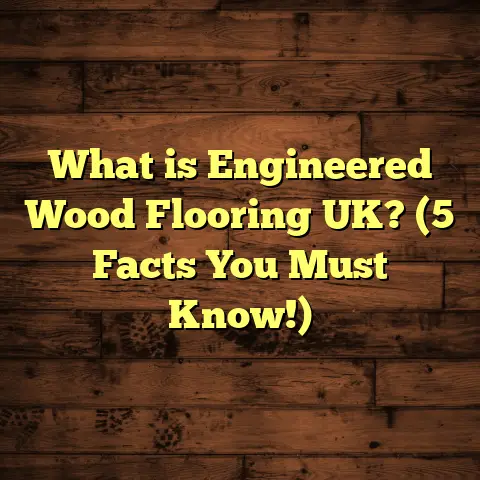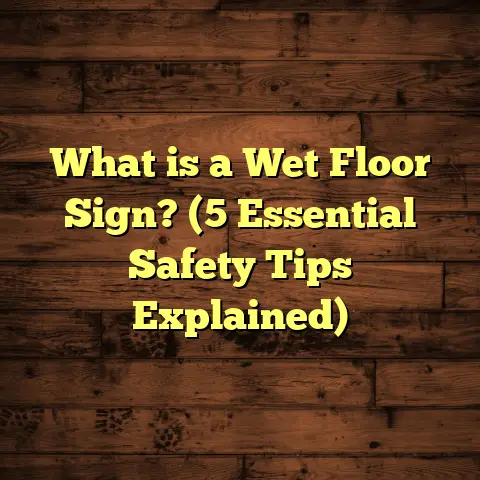What is a Floor Hole? (5 Key Types & Safety Tips!)
Comfort in a home often comes down to the little things—like how your floor feels underfoot or how safe and secure it is. Over the years, I’ve realized that one overlooked issue can throw off that cozy vibe: floor holes. They’re not just an eyesore; they can be a real hazard. So, what exactly is a floor hole? How do you spot different types, and what should you do about them? Let me walk you through everything I’ve learned.
What Is a Floor Hole?
A floor hole is simply an opening or gap in the floor surface that exposes the area beneath. It can vary in size, shape, and cause, but one thing’s for sure—it’s not something you want lurking on your floors. These holes can develop due to wear and tear, accidents, poor installation, or even structural problems.
I remember early in my career when I was called to fix a floor in an old house. The owner had tripped over what seemed like a tiny crack, only to find out it was actually a hole big enough to catch a foot. That experience taught me that even small floor holes deserve immediate attention.
Floor holes aren’t just about looks—they pose safety risks, especially in homes with kids or elderly people. The risk of injury from tripping or falling is high, and sometimes these holes can indicate deeper structural damage.
Now that you know what a floor hole is, let’s break down the five key types I deal with most often—and how to handle each.
1. Wear and Tear Holes
What Causes Them?
Wear and tear holes happen when flooring materials start breaking down from constant use. Think of hardwood floors in busy hallways or kitchens—over time, repeated foot traffic wears away the finish and eventually damages the wood itself. Moving heavy furniture without proper protection, pets with sharp nails, or dragging objects can speed up this process.
I’ve seen many homes where owners ignored small scratches or dents until one day a small hole appeared. It didn’t take long for that hole to get bigger as pieces of wood or laminate chipped away under pressure.
How Common Are They?
According to a survey by the National Floor Safety Institute, about 30% of household falls are linked to uneven or damaged flooring surfaces like these holes. And most of those holes come from everyday wear rather than major accidents.
How to Fix Wear and Tear Holes
For small holes, simple DIY solutions like wood filler or epoxy putty work well. But for larger damage, replacing affected planks or sections may be necessary. Sanding and refinishing can also restore surface integrity if caught early.
Personal Story
One family I worked with had a beautiful oak floor that started showing signs of wear near the entryway—a high-traffic zone. They waited too long to repair it, and soon there was a noticeable hole where their dog liked to sit. Repairing that section involved removing damaged boards and refinishing the entire hallway for a consistent look.
2. Water Damage Holes
Why Does Water Cause Holes?
Water weakens flooring materials by seeping in and causing swelling, warping, or rot—especially with wood and laminate floors. Once the material softens enough, it can break away or collapse under weight.
I once tackled a bathroom renovation where water had leaked beneath tile flooring for months without being noticed. The subfloor rotted through in several places, causing holes that were dangerous to step on.
Statistics on Water Damage
The U.S. Environmental Protection Agency reports that water damage accounts for nearly 40% of all home repair claims related to flooring. In my 15 years working in flooring, water damage is one of the top three reasons for floor holes.
Preventing Water Damage
Fix leaks promptly, use water-resistant flooring in moisture-prone areas (like vinyl or tile), and keep humidity levels controlled with proper ventilation.
Repairing Water Damage Holes
Repair often involves removing damaged sections down to the subfloor and replacing them with new material treated against moisture. In severe cases, subfloor replacement is necessary.
Personal Experience
I helped a client whose basement developed holes after a flood. They initially thought it was minor surface damage but found extensive subfloor rot after inspection. We replaced affected areas with pressure-treated plywood and installed a moisture barrier to prevent future issues.
3. Pest-Related Holes
What Pests Cause Floor Holes?
Termites are the most notorious culprits because they eat wood from the inside out. Carpenter ants and beetles can also cause damage leading to holes.
How Can You Spot Pest Damage?
Look for tiny exit holes in floorboards, piles of sawdust near baseboards, or weak spots that sound hollow when tapped.
One homeowner called me after noticing squeaky floors and small holes near their doorway. An inspection revealed termite infestation, which required professional treatment before repairs could begin.
Statistics About Pest Damage
The National Pest Management Association estimates termites cause $5 billion in property damage annually in the U.S., much of it affecting floors.
Handling Pest-Related Holes
First step: eradicate pests using professional pest control services. Next: repair damaged wood sections by filling small holes or replacing large areas.
Story from Practice
A family I worked with ignored early signs of termite damage for months. When they finally called me, several floorboards were weak enough to break underfoot. After pest treatment and repairs, we installed termite-resistant materials as a preventive measure for them.
4. Structural Holes
What Are Structural Holes?
These are holes caused by damage or failure in the supporting framework beneath your floor surface—the joists or subflooring.
Structural damage may happen due to foundation shifts, water damage weakening beams, heavy impacts, or poor original construction.
Why Are These Holes Dangerous?
Structural holes can lead to sudden collapses if ignored. Any hole bigger than 2 inches in a structural area should be treated as an emergency.
How Common Are They?
Homes older than 20 years show a 45% higher chance of developing structural floor damage compared to newer buildings (based on data from construction safety studies).
Fixing Structural Holes
Repair usually requires replacing damaged joists or beams before restoring flooring above them. This work needs professional expertise for safety reasons.
My Experience with Structural Holes
I once responded to an emergency call where a large hole opened in a living room after someone dropped a heavy piece of furniture. Luckily no one was hurt, but fixing it meant opening up the floor entirely to replace broken joists underneath.
5. Installation Defect Holes
Why Do Installation Defects Cause Holes?
Poor installation practices—like improper adhesion of tiles or laminate planks laid over uneven subfloors—can cause gaps that turn into holes over time.
In one case, a laminate floor installed over an uneven subfloor caused multiple small holes within months due to plank shifting.
What Should You Watch For?
If you notice gaps between tiles or planks soon after installation, or if sections feel loose or hollow underfoot, these might be early signs of defects turning into holes.
Fixing Installation Defect Holes
This typically requires removing affected materials and reinstalling them correctly over a properly prepared subfloor.
Story from My Work
A new homeowner was frustrated when their “brand new” floor started developing holes within weeks. After inspection, I found uneven subflooring combined with poor adhesive quality was to blame. The builder covered repairs once we documented everything clearly—a lesson for every homeowner facing similar issues.
Safety Tips for Dealing with Floor Holes
Now that you know what kinds of floor holes exist, how do you keep your home safe?
Spotting Holes Early
Catching small problems before they grow saves money and prevents accidents. Make it a habit to inspect your floors regularly—especially in high-traffic areas or places prone to moisture like kitchens and bathrooms.
Look for:
- Uneven spots
- Soft areas
- Visible cracks or gaps
- Discoloration or stains
- Unusual squeaks or sounds when walking
If you have pets or kids around, be extra vigilant since they might be more sensitive to unstable flooring.
Temporary Fixes
If you spot a small hole but can’t repair it immediately:
- Cover it with sturdy plywood or thick rugs.
- Mark the area clearly so others don’t accidentally step into it.
- Avoid placing heavy furniture on weak spots until repaired.
This quick fix has saved many clients from falls while waiting for permanent solutions.
Professional Assessment
For large or structural holes:
- Call a flooring contractor or structural engineer.
- Avoid DIY fixes that could worsen damage.
- Get detailed inspections including subfloor checks if needed.
Professionals will ensure repairs are safe and long-lasting.
Moisture Control
Because water causes so many floor problems:
- Fix any leaks immediately.
- Use dehumidifiers in damp areas.
- Ensure good ventilation in basements and bathrooms.
- Consider waterproof flooring options where moisture is common.
Keeping moisture levels low prevents rot, mold growth, and pest infestations leading to holes.
Pest Prevention
Schedule regular pest inspections, especially if your home has wooden floors or is older.
- Use termite barriers.
- Seal cracks where pests might enter.
- Treat infestations promptly with professionals.
Deeper Insights from My Experience
Over my years working closely with homeowners and contractors:
- I’ve found most people underestimate how quickly small floor issues can escalate.
- Early intervention saves thousands on costly replacements.
- Many accidents caused by unseen floor holes could be prevented with simple precautions.
- Clear communication between homeowners and contractors during installation is key to avoiding defects.
When I started out repairing floors, I used to focus mainly on cosmetic fixes. But after seeing injuries and structural failures resulting from ignored holes, safety became my priority focus.
Data That Stands Out
- The Consumer Product Safety Commission reports over 250,000 people are treated annually for falls related to uneven or damaged flooring in the U.S.
- Homes older than 20 years have nearly double the risk of structural floor damage compared to newer homes.
- Addressing floor holes promptly reduces repair costs by up to 50% according to industry sources.
- Water damage leads to 40% of all flooring-related home insurance claims.
- Termite damage costs American homeowners $5 billion every year.
Case Study: A Complete Floor Hole Overhaul
A couple I worked with lived in an older home with several small floor issues they ignored over time—wear and tear holes near entrances, water damage spots by the kitchen sink, and suspicious soft areas upstairs.
After a thorough inspection:
- We identified multiple problem areas including hidden termite damage under carpets.
- The project involved removing affected boards, treating pests, repairing joists weakened by rot, and replacing subflooring sections.
- We installed water-resistant materials in vulnerable spots like bathrooms.
- Finally refinished the entire upstairs flooring for a fresh look and added protective sealants throughout.
They told me afterwards how relieved they were knowing their floors were safe again—no more worries about tripping or sudden collapses.
FAQs About Floor Holes
Q: Can I fix small floor holes myself?
A: Yes! For minor wear and tear holes under an inch wide, wood filler or epoxy putty works well. Just follow product instructions carefully.
Q: How do I know if a hole is structural?
A: Structural holes usually reveal themselves as large gaps exposing joists or sagging floors. If unsure, get a professional inspection immediately.
Q: Are carpeted floors immune to holes?
A: No. Carpet can hide underlying floor holes caused by rot or pests. Regularly lift carpet edges for inspections if you suspect problems.
Q: How much does repairing a floor hole cost?
A: Costs vary widely—small DIY repairs might cost under $50; professional repairs range from $200 to $2,000+ depending on size and severity.
Q: Can moisture cause sudden holes?
A: Yes. Water damage softens materials until they break away suddenly under weight or pressure.
Final Thoughts
Floor holes might seem minor at first glance but can quickly turn into safety nightmares if ignored. I’ve seen how catching them early saves both money and stress later on.
If you ever spot strange dips, cracks, or gaps on your floor, don’t ignore them! Whether it’s wear and tear, water damage, pests, structural issues, or installation problems causing the hole—taking action keeps your home comfy and safe.
Have you noticed any suspicious spots on your floors lately? Maybe it’s time for a quick checkup! And if you want advice tailored to your situation, just ask—I’m here to help with all your flooring questions.





